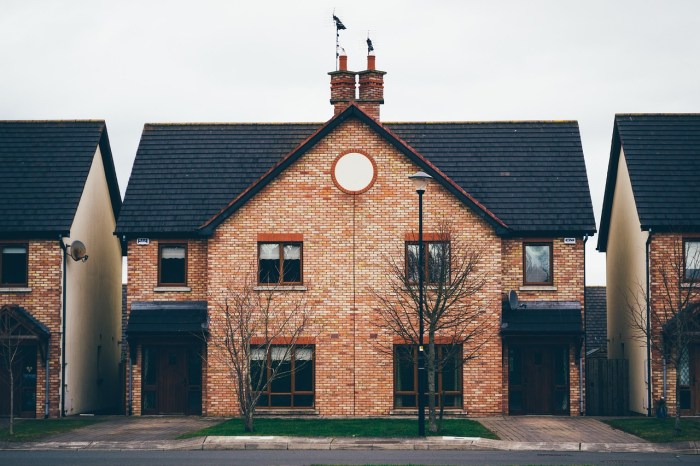Buildings insurance, often overlooked until disaster strikes, is a crucial financial safeguard for homeowners, landlords, and businesses alike. Understanding the nuances of different policy types, coverage specifics, and the claims process can be the difference between financial stability and crippling debt after an unforeseen event. This guide delves into the complexities of buildings insurance, offering a clear and concise overview to empower you with the knowledge to make informed decisions.
From identifying the type of policy best suited to your needs – be it homeowner’s, landlord’s, or commercial – to understanding the factors influencing premium costs and navigating the claims process, we aim to demystify the world of buildings insurance. We will also explore preventative measures to mitigate risks and guide you through choosing a reliable provider. This comprehensive guide is your one-stop resource for securing the future of your property.
Types of Buildings Insurance
Choosing the right buildings insurance is crucial for protecting one of your most significant assets. Understanding the different types of policies available ensures you have the appropriate coverage for your specific needs and circumstances. This section will detail the key differences between homeowner’s, landlord’s, and commercial property insurance, highlighting their coverage, typical policyholders, and common exclusions.
Building Insurance Policy Types
The market offers various buildings insurance policies, each tailored to specific property ownership structures and usage. Understanding these nuances is critical for selecting the most suitable protection. The following table summarizes the key differences between three common types: homeowner’s, landlord’s, and commercial property insurance.
| Insurance Type | Coverage Details | Typical Policyholders | Key Exclusions |
|---|---|---|---|
| Homeowner’s Insurance | Covers the structure of a privately owned home, including attached structures like garages. Often includes liability coverage for injuries on the property. May offer additional coverage for personal belongings (contents insurance, often purchased separately). | Individuals who own and live in their homes. | Typically excludes damage caused by wear and tear, neglect, or intentional acts. Flood and earthquake damage are often excluded unless specifically added as endorsements. Coverage for business activities conducted within the home may be limited or excluded. |
| Landlord Insurance | Covers the building structure itself, but typically excludes the contents of the rental units. Provides protection against damage to the building and potential loss of rental income due to insured perils. Liability coverage is often included to protect against tenant-related claims. | Individuals or companies who own and rent out properties. | Similar exclusions to homeowner’s insurance apply, including wear and tear, neglect, and intentional acts. Damage caused by tenants (unless due to a covered peril) may also be excluded. Contents within the rental units are generally not covered. |
| Commercial Property Insurance | Covers a wide range of commercial buildings, including offices, retail spaces, and industrial facilities. Covers the building structure, as well as business personal property (equipment, inventory). May include business interruption coverage to compensate for lost income due to covered events. | Businesses that own or lease commercial properties. | Exclusions vary widely depending on the policy and the nature of the business. Common exclusions include damage caused by faulty workmanship, wear and tear, and certain types of pollution. Specific exclusions related to the business operations may also apply. |
Comparison of Building Insurance Coverage
While all three types of insurance protect the building structure, the scope of coverage and the typical policyholders differ significantly. Homeowner’s insurance is primarily for owner-occupied residences, focusing on the building’s structure and liability for personal injury on the property. Landlord insurance shifts the focus to protecting the investment property and covering potential loss of rental income, while excluding the tenant’s belongings. Commercial property insurance broadens the scope to encompass a variety of business-related risks, including business interruption and the protection of business property.
Specific Risks Covered Under Each Type
Each policy type covers a range of specific risks. Homeowner’s insurance commonly covers damage from fire, windstorms, hail, and vandalism. Landlord insurance similarly covers these perils, but also includes protection against loss of rental income due to damage caused by covered events. Commercial property insurance extends coverage to a wider array of risks relevant to businesses, including fire, theft, vandalism, and potentially even business interruption. However, the specifics of what is covered will vary depending on the individual policy and any added endorsements. It is crucial to review the policy wording carefully to understand the exact extent of coverage.
Claims Process and Procedures

Filing a buildings insurance claim can seem daunting, but understanding the process and necessary steps can significantly ease the experience. This section details the procedures involved, required documentation, and strategies to expedite the process. Remember, prompt and accurate communication with your insurer is key throughout.
The claims process typically involves several key stages, from initial notification to final settlement. The specific steps may vary slightly depending on your insurer and the nature of the damage, but the overall principles remain consistent. Effective communication and thorough documentation are essential for a smooth and efficient claims resolution.
Required Documentation for a Buildings Insurance Claim
Supporting your claim with comprehensive documentation is crucial for a swift and successful outcome. This typically includes, but is not limited to, photographic evidence of the damage, details of the incident, and any relevant repair quotes. The more complete your documentation, the quicker your claim is likely to be processed.
Examples of essential documents include: your insurance policy details; photographs and videos documenting the damage from multiple angles; police reports (if applicable, such as in cases of vandalism or theft); detailed repair estimates from qualified contractors; receipts for any temporary repairs or expenses incurred as a result of the damage; and any other relevant documentation that supports your claim, such as witness statements.
Strategies to Expedite the Claims Process
Several proactive steps can significantly accelerate the claim processing time. These steps focus on efficient communication, thorough documentation, and prompt cooperation with the insurer’s investigation.
Prompt notification of the incident is paramount. Contact your insurer immediately following the event to report the damage. Gather all necessary documentation as quickly as possible and submit it in a well-organized manner. Maintain open communication with your claims adjuster, responding promptly to their requests for information. Consider using a secure online portal if available for efficient document submission and tracking.
Step-by-Step Guide for Handling a Buildings Insurance Claim
A methodical approach to handling your claim can minimize stress and ensure a smoother process. Following these steps will help guide you through each stage.
- Report the incident immediately: Contact your insurer as soon as possible after the damage occurs, providing initial details of the event and the extent of the damage.
- Document the damage: Take comprehensive photographs and videos of the damage from various angles. Note the date and time of each photo/video.
- Gather supporting documentation: Collect all relevant documents, including your policy details, repair estimates, receipts, and any other supporting evidence.
- File your claim formally: Complete the claim form provided by your insurer, ensuring all information is accurate and complete.
- Cooperate with the insurer’s investigation: Respond promptly to any requests for information or inspections from your claims adjuster.
- Review and accept the settlement offer: Once the insurer completes their investigation, they will present a settlement offer. Review this carefully and discuss any concerns with your adjuster before accepting.
Protecting Your Building from Damage

Protecting your building from damage is crucial not only to maintain its value and functionality but also to mitigate potential financial losses. Regular maintenance and proactive safety measures significantly reduce the risk of costly repairs and insurance claims, ultimately leading to greater peace of mind. Implementing preventative strategies can also positively impact your insurance premiums, offering substantial long-term savings.
Proactive measures significantly reduce the likelihood of damage and the associated costs. By addressing potential vulnerabilities before they become problems, you can safeguard your investment and demonstrate responsible property management to your insurer. This preventative approach fosters a safer environment and minimizes disruption should an unforeseen event occur.
Preventative Maintenance Strategies
Regular maintenance is the cornerstone of protecting your building. This involves scheduled inspections and timely repairs to address issues before they escalate. For example, promptly fixing a leaking roof prevents further water damage that could compromise the building’s structure and lead to costly mold remediation. Similarly, regular gutter cleaning prevents water accumulation and overflow, which can damage foundations and walls. These proactive steps demonstrate responsible ownership and can favorably influence insurance assessments.
Safety Measures to Lower Insurance Premiums
Implementing specific safety measures can demonstrably lower your insurance premiums. Many insurers offer discounts for features that reduce the risk of damage. Installing fire alarms and sprinklers, for example, is a common example. These systems minimize fire damage, a significant risk factor for buildings. Similarly, security systems, including alarms and surveillance cameras, deter burglaries and vandalism, reducing the potential for damage and associated insurance claims. Upgrades like reinforced doors and windows also contribute to enhanced security and lower premiums. Insurers often reward proactive risk mitigation with reduced premiums, reflecting the lower likelihood of claims.
Practical Steps for Property Protection
Taking practical steps to protect your property is essential. This involves both regular maintenance and the implementation of safety features.
- Regularly inspect your roof, checking for leaks, damaged shingles, or missing tiles.
- Clean gutters and downspouts to prevent water damage to the foundation.
- Inspect and maintain plumbing systems to prevent leaks and water damage.
- Schedule regular electrical inspections to identify and address potential hazards.
- Install and maintain smoke detectors and carbon monoxide detectors.
- Install and regularly test fire extinguishers.
- Implement a comprehensive pest control program to prevent damage from insects and rodents.
- Trim trees and shrubs near the building to prevent damage from falling branches.
- Secure all doors and windows with high-quality locks.
- Consider installing a security system with alarm and surveillance capabilities.
Conclusive Thoughts

Securing adequate buildings insurance is not merely a financial transaction; it’s an investment in peace of mind. By understanding the intricacies of policy coverage, the claims process, and the various factors affecting premiums, you can confidently protect your valuable asset. Remember to regularly review your policy, consider preventative measures, and choose a reputable provider to ensure you’re adequately protected against unforeseen circumstances. Taking proactive steps to secure your building’s future is a crucial element of responsible ownership.
Question Bank
What is the difference between buildings insurance and contents insurance?
Buildings insurance covers the structure of the building itself (walls, roof, etc.), while contents insurance covers the personal belongings inside.
How long does it typically take to process a buildings insurance claim?
Processing times vary depending on the insurer and the complexity of the claim, but generally range from a few days to several weeks.
Can I get buildings insurance if my property is a listed building?
Yes, but you may need to find a specialist insurer as listed buildings often have unique requirements and higher premiums.
What happens if I don’t have buildings insurance and my property is damaged?
You will be responsible for the full cost of repairs or rebuilding, which can be substantial. You may also face legal repercussions depending on your situation (e.g., as a landlord).
Can I increase my buildings insurance coverage mid-term?
Generally, yes, but you’ll likely need to contact your insurer and may be required to pay a higher premium to reflect the increased coverage.